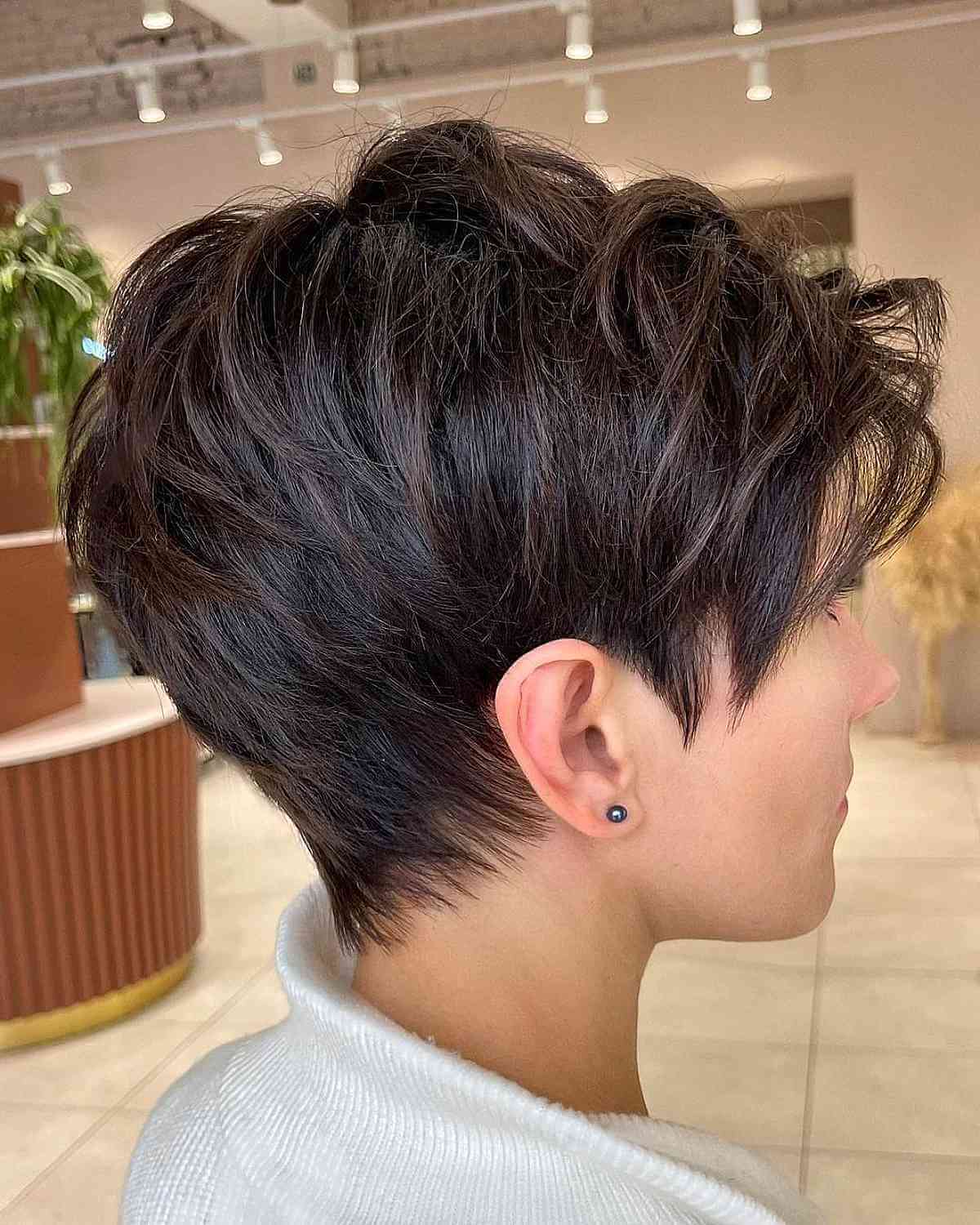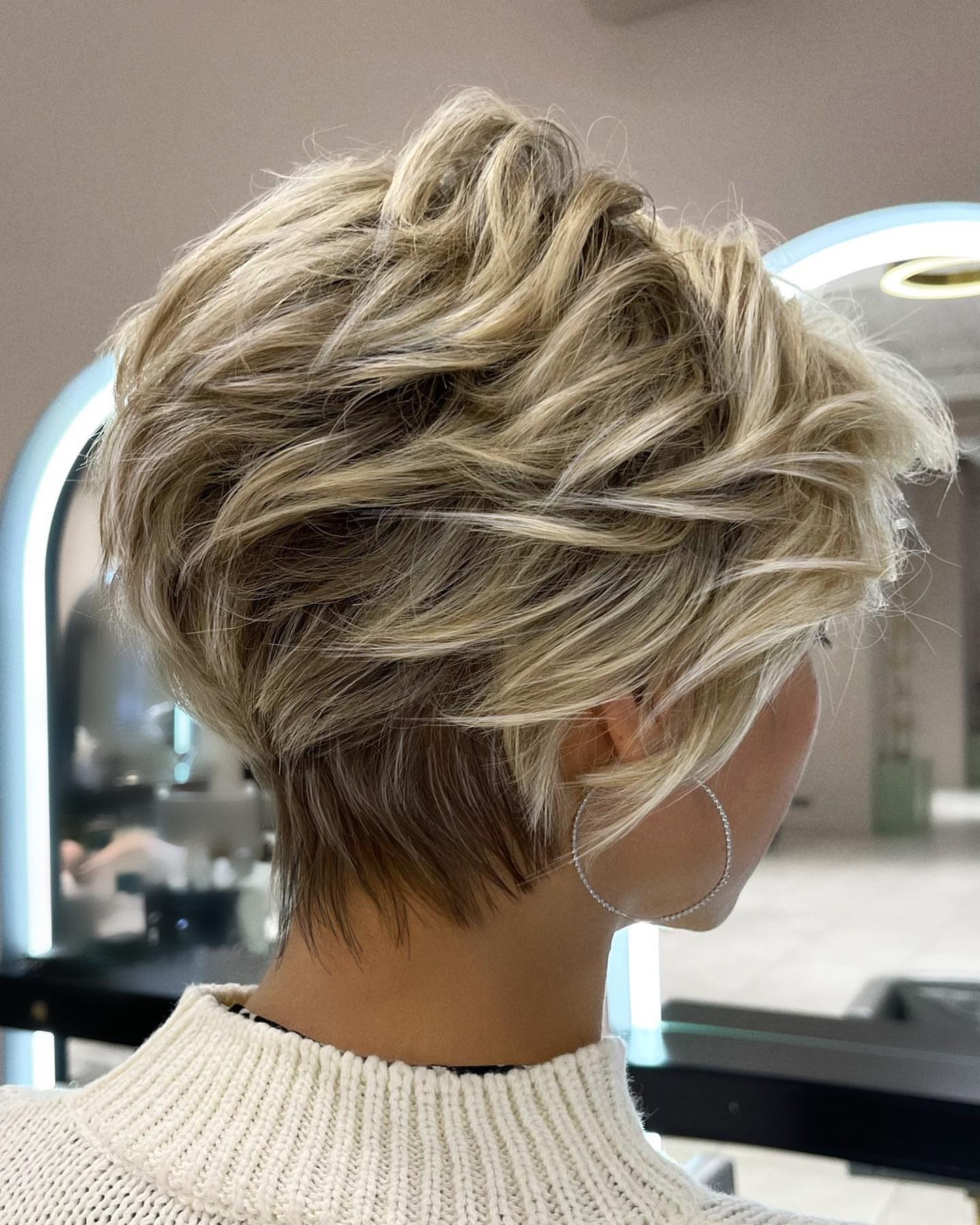The Back of Hairstyles: A Comprehensive Insight into Rear View Aesthetics

The comprehensive artistry of hair design extends far beyond the frontal presentation, encompassing the often-underestimated aesthetic and structural integrity of the style when viewed from behind. This posterior perspective, while frequently unseen by the individual, holds profound significance in defining the overall sophistication, balance, and professionalism of any coiffure. A truly accomplished hair arrangement is meticulously crafted to offer visual appeal from all angles, ensuring that its full silhouette contributes to a cohesive and polished image. The careful consideration given to the nape, crown, and occipital regions of a hair design transcends mere detail; it is fundamental to the perception of a complete and harmonious look.
Historically, the significance of hind hair arrangement has been documented across various cultures and eras. Ancient Egyptian and Roman coiffures, for instance, frequently featured intricate braids, knots, and ornamentation that were strategically placed to enhance the profile and the view from behind. During the Baroque and Rococo periods, towering updos and elaborate powdered wigs often incorporated complex structures and decorative elements at the back, signifying status and grandeur. Victorian and Edwardian styles, with their elaborate chignons and Gibson Girl rolls, showcased exquisite attention to the sculpted forms at the back of the head, requiring considerable skill to execute. These historical precedents underscore a consistent recognition that the complete presentation of hair, including its rearward elements, is integral to personal expression and societal communication.
From a technical standpoint, the successful execution of rearward hair aesthetics begins with precision cutting. Layers, graduation, and shaping around the nape and lower crown are critical for establishing the foundation of a style. Without proper blending and weight distribution in these areas, even the most artfully styled front can appear disconnected or unkempt from the side or rear. For short hairstyles, such as bobs, pixies, or crops, the contouring of the neck and occiput is paramount. A clean, tapered neckline or a carefully stacked graduation provides the structural framework that defines the style’s overall shape and longevity. In longer styles, the management of bulk, the flow of layers, and the integrity of the perimeter line become central. The manner in which hair falls, whether in soft cascades or precise lines, dictates the elegance and movement perceived from behind.
Styling techniques specifically applied to the posterior region of a hair arrangement are diverse and crucial. For updos, the anchoring, pinning, and shaping of the hair at the crown and nape are foundational. The creation of intricate braids, twists, or rolls requires meticulous sectioning and tension control to ensure neatness and durability. The placement of hairpins, elastics, and decorative accessories must be discreet yet effective, preventing slippage and maintaining the desired form. For down styles, the finishing touches, such as smoothing flyaways, adding texture, or defining curls, extend to the furthest reaches of the hair to ensure a polished appearance from all vantage points. Even a simple ponytail or bun benefits immensely from attention to its base and the uniformity of its mass when viewed from behind.
The importance of the hind aspect of hair design is particularly evident in professional settings, formal events, and public appearances. A well-executed professional coiffure, for example, conveys meticulousness and attention to detail, qualities highly valued in the workplace. An errant strand or a poorly defined line at the nape can detract from an otherwise impeccable presentation. At formal gatherings, where individuals are often observed from multiple angles, the elegance of an updo or the sleekness of a long, styled mane, as seen from behind, contributes significantly to the overall impression of grace and sophistication. For public figures, whose image is constantly scrutinized, the consistency of their hair presentation from every angle is a non-negotiable aspect of their brand.
Moreover, the perception of hair health and vitality is heavily influenced by its appearance when viewed from the rear. Split ends, frizz, or uneven growth are often more noticeable in the unstyled or poorly maintained hind sections of the hair. Conversely, a smooth, lustrous finish that extends uniformly to the tips communicates vitality and proper care. The natural fall and movement of hair, particularly when in motion, are also best appreciated from this perspective, highlighting the craftsmanship involved in achieving a dynamic and fluid style.
Challenges in maintaining the pristine appearance of posterior hair elements include difficulty in self-styling and the impact of environmental factors. Individuals often find it challenging to precisely style or inspect the back of their own head, leading to reliance on mirrors or professional assistance. Humidity, wind, and friction from clothing or seating can also disrupt the carefully arranged forms at the nape and crown, necessitating products and techniques that offer enhanced hold and resilience. The selection of appropriate styling products, such as setting sprays, anti-frizz serums, or texturizing creams, is therefore critical to ensure the longevity and integrity of the aesthetic presentation from behind.
From the perspective of a hair professional, the mastery of occipital styling is a hallmark of expertise. Stylists are trained to envision the complete three-dimensional form of a hairstyle, understanding how each cut and style decision impacts the overall silhouette. Consultations often include discussions about how a style will look from all angles, not just the front. The ability to create seamless transitions, harmonious volume, and impeccable finishing at the rear of a client’s head distinguishes a skilled artisan from a novice. This comprehensive approach ensures client satisfaction and reinforces the value of professional hair care.
In contemporary fashion and personal grooming, the detailed consideration of a style’s complete circumference, including its rear view, remains highly relevant. Social media platforms, with their emphasis on visual documentation, mean that hairstyles are photographed and shared from various perspectives. This increased visibility has heightened awareness among individuals about the importance of a polished appearance from all angles. From intricate braids that showcase detailed patterns down Types Of Hairstyles With Bangs A Comprehensive Guide To Fringe Variations the spine to perfectly executed bobs that highlight a sharp, clean line at the neck, the posterior elements of hair design continue to be a focal point for trendsetters and everyday individuals alike. The complete aesthetic experience of a hairstyle is thus undeniably dependent on the artistry and precision applied to its often-unseen dimensions.
FAQs by the Back of Hairstyles
Q: Why is attention to the rear aspect of a hairstyle considered so important?
A: The careful crafting of a hairstyle’s posterior elements is crucial for achieving a balanced, polished, and professional appearance from all angles. It ensures the style’s structural integrity, contributes to its overall silhouette, and reflects meticulous attention to detail, which impacts the perception of elegance and competence.
Q: Are specific cutting techniques used to enhance the hind portions of a style?
A: Yes, techniques such as graduation, stacking, tapering, and precise layering are frequently employed to sculpt the hair around the nape and occipital bone. These methods create desired shapes, volume, and movement, forming the essential foundation for how the style appears from behind.
Q: How do updos specifically address the aesthetic of the posterior hair design?
A: Updos are inherently designed with a strong emphasis on their rear presentation. The intricate pinning, twisting, braiding, and shaping of hair at the crown and nape are central to their construction. The placement of accessories and the creation of specific textures are meticulously planned to enhance the visual appeal from behind.
Q: What challenges arise when trying to maintain the integrity of a style’s rear view?
A: Challenges include the difficulty of self-styling and inspecting the back of one’s own head, leading to potential oversight. Environmental factors such as wind, humidity, and friction from clothing can also disrupt the carefully arranged elements, necessitating effective styling products and regular maintenance.
Q: Does hair health impact the appearance of the posterior sections of a style?
A: Absolutely. The health and condition of hair, including the absence of split ends, frizz, and damage, are often more visibly apparent in the unstyled or less-managed posterior sections. A healthy, lustrous finish at the rear contributes significantly to the perception of overall hair vitality.
Tips by the Back of Hairstyles
- Utilize a Dual Mirror System: To ensure thoroughness in styling and inspection, employ a large wall mirror in conjunction with a handheld mirror. This allows for a comprehensive view of all angles, facilitating precise adjustments to the posterior sections of the hair.
- Invest in Quality Styling Products: Select products specifically formulated for hold, anti-frizz, and shine that are appropriate for the hair type and desired style. These products are essential for maintaining the integrity and polished appearance of the rearward hair elements throughout the day.
- Prioritize Precision Cutting: Communicate clearly with a hair professional about the desired shape and contour of the hair at Virtual Hairstyles For Women Over Exploring Digital Transformations For Mature Beauty the nape and occipital region. A well-executed cut provides the foundational structure that simplifies styling and enhances the style’s longevity when viewed from behind.
- Practice Sectioning and Pinning Techniques: For styles involving updos or intricate designs, practice dividing hair into clean sections and securing them with appropriate tension. This skill is critical for achieving neatness and stability in the posterior arrangement.
- Address Hair Health Consistently: Regular conditioning treatments, gentle brushing, and protection from heat damage are vital. Healthy hair with smooth cuticles will naturally present a more polished and appealing appearance from the rear, minimizing frizz and promoting shine.
Conclusion by the Back of Hairstyles
The meticulous consideration and expert execution of a hairstyle’s posterior presentation represent a fundamental aspect of comprehensive hair artistry. Far from being a mere afterthought, the aesthetic integrity of the nape, crown, and occipital regions is pivotal in defining the overall balance, sophistication, and professional polish of any coiffure. This attention to detail ensures that a style appears cohesive and refined from every perspective, contributing significantly to an individual’s perceived image and confidence. The ongoing evolution of styling techniques, product innovations, and professional expertise continues to underscore the enduring importance of this often-unseen dimension, solidifying its status as an indispensable component of truly exceptional hair design.







More suggestion: Why Are Cats Hairless A Comprehensive Exploration Of Feline Alopecia